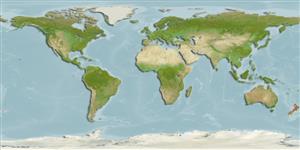>
Blenniiformes (Blennies) >
Tripterygiidae (Triplefin blennies) > Tripterygiinae
Etymology: Notoclinops: Greek, noton = back + Greek, klinein, kline = sloping and also bed, due to the four apophyses of sphenoid bone + Greek, ops = appearance (Ref. 45335).
Environment: milieu / climate zone / depth range / distribution range
экология
морской демерсальный; пределы глубины 0 - 40 m (Ref. 9003). Subtropical
Southwest Pacific: mainland New Zealand.
Size / Вес / Возраст
Maturity: Lm ? range ? - ? cm
Max length : 4.4 cm SL самец/пол неопределен; (Ref. 13227)
Краткое описание
морфология | морфометрия
колючие лучи спинного плавника (общее число): 20 - 23; членистые (мягкие) лучи спинного плавника (общее число): 10-13; колючие лучи анального плавника 1; членистые (мягкие) лучи анального плавника: 24 - 25. Pinkish over head and body with faint brown lines on head, nine evenly spaced reddish brown vertical bands on body. Dorsal fins pinkish with a thin colorless stripe running horizontally. Distinguished from other triplefins, other than Notoclinops caerulepunctus by the bright blue eyes.
Adults prefer areas of broken rock, steep rock faces and overhangs in areas without large algae and a thick cover of crustose coralline algae. They feed on small crustaceans (e.g. amphipods and copepods). They remove parasites from larger fish. Males are territorial during the breeding season dutifully guarding the eggs in the nests (Ref. 9003). Eggs are hemispherical and covered with numerous sticky threads that anchor them in the algae on the nesting sites (Ref. 240). Larvae are planktonic which occur primarily in shallow, nearshore waters (Ref. 94114).
Life cycle and mating behavior
половая зрелость | размножение | нерест | икра | Fecundity | личинки
Fricke, R., 1994. Tripterygiid fishes of Australia, New Zealand and the southwest Pacific Ocean (Teleostei). Theses Zool. 24:1-585. (Ref. 13227)
Статус Красного Списка МСОП (Ref. 130435)
Угроза для людей
Harmless
Использование человеком
рыболовство: интереса не представляет
дополнительная информация
ссылкиаквакультура (рыбоводство)особенности рыбоводствастепень растяжениягенетикаElectrophoresesнаследуемостьболезниобработкаNutrientsMass conversion
соавторыизображенияStamps, Coins Misc.звукиCiguateraскоростьтип плаванияжаберная областьOtolithsмозгзрение
инструменты
Специальные отчеты
Скачать в формате XML
ресурсы в Интернет
Estimates based on models
Preferred temperature (Ref.
123201): 15.1 - 19.5, mean 17.7 °C (based on 24 cells).
Phylogenetic diversity index (Ref.
82804): PD
50 = 0.6250 [Uniqueness, from 0.5 = low to 2.0 = high].
Bayesian length-weight: a=0.00661 (0.00340 - 0.01283), b=3.10 (2.92 - 3.28), in cm total length, based on LWR estimates for this species & (Sub)family-body (Ref.
93245).
Trophic level (Ref.
69278): 3.3 ±0.0 se; based on diet studies.
устойчивость к внешним воздействиям (Ref.
120179): высокий, минимальное время удвоения популяции до 15 месяцев (Preliminary K or Fecundity.).
Fishing Vulnerability (Ref.
59153): Low vulnerability (10 of 100).
Nutrients (Ref.
124155): Calcium = 606 [247, 2,131] mg/100g; Iron = 3.65 [1.57, 7.97] mg/100g; Protein = 18.7 [17.2, 20.0] %; Omega3 = 0.43 [0.15, 1.27] g/100g; Selenium = 36.2 [9.7, 109.1] μg/100g; VitaminA = 9.12 [1.81, 48.47] μg/100g; Zinc = 2.66 [1.34, 4.66] mg/100g (wet weight);
